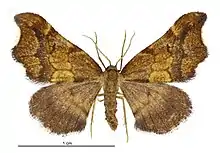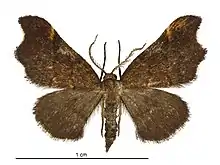Paradetis
Paradetis is a monotypic moth genus in the family Geometridae.[2] Its only species, Paradetis porphyrias, is endemic to New Zealand. The genus and species were first described by Edward Meyrick, the genus in 1885 and the species in 1883.
| Paradetis | |
|---|---|
 | |
| Female | |
 | |
| Male | |
| Scientific classification | |
| Kingdom: | |
| Phylum: | |
| Class: | |
| Order: | |
| Family: | |
| Subfamily: | |
| Genus: | Paradetis Meyrick, 1885 |
| Species: | P. porphyrias |
| Binomial name | |
| Paradetis porphyrias (Meyrick, 1883) | |
| Synonyms[1] | |
|
Generic
Specific
| |
Taxonomy
This species was first described by Meyrick in 1883 under the name Parysatis porphyrias.[3][4] Meyrick went on to give a more detailed description of the species in 1884.[5] In 1886 Meyrick renamed the genus of this species Paradetis.[6]
George Hudson illustrated and discussed this species under its current name Paradetis porphyrias in both of his books New Zealand Moths and Butterflies (Macro-lepidoptera) in 1898 and The Butterflies and Moths of New Zealand in 1928.[7][8]
Description
Meyrick described the species as follows:
Female. — 20 mm. Forewings moderate, costa sinuate in middle, apex almost acute, hindmargin deeply excavated on upper half and more shortly on lower third, so as to project bluntly below middle; yellow-ochreous, irregularly mixed with brown and purplish; veins clearly marked with fuscous; two slender ochreous-brown transverse lines, dilated on costa, first before middle, bent inwards near costa, second beyond middle, almost straight; beyond second a broad purplish shade, except near costa, dilated beneath to reach hindmargin; hindmargin purple: cilia white on excavations. Hindwings moderate, hindmargin shortly sinuate near inner angle; pale ochreous mixed with fuscous and purplish; a fuscous transverse fine before middle; a very broad purplish hindmarginal band.[5]
Distribution
P. porphyrias is endemic to New Zealand.[9] Meyrick first collected the species near Otira Gorge at Arthur's Pass in January.[5] The species has also been found at Mount Arthur, Castle Hill, and Lake Wakatipu.[8]
Habitat and host species
.jpg.webp)
Alfred Philpott mentioned that the species frequented the banks of mountain streams.[10] P. porphyrias larvae likely feed on Hypolepis millefolium.[11]
References
| Wikimedia Commons has media related to Paradetis porphyrias. |
- Beccaloni, G.; Scoble, M.; Kitching, I.; Simonsen, T.; Robinson, G.; Pitkin, B.; Hine, A.; Lyal, C., eds. (2003). "Paradetis". The Global Lepidoptera Names Index. Natural History Museum. Retrieved 19 May 2019.
- Beccaloni, G.; Scoble, M.; Kitching, I.; Simonsen, T.; Robinson, G.; Pitkin, B.; Hine, A.; Lyal, C., eds. (2003). "Paradetis". The Global Lepidoptera Names Index. Natural History Museum. Retrieved 19 May 2019.
- Dugdale, J. S. (1988). "Lepidoptera - annotated catalogue, and keys to family-group taxa" (PDF). Fauna of New Zealand. 14: 186. Retrieved 23 December 2018.
- Meyrick, Edward (1883). "Monograph of New Zealand Geometrina [abstract]". New Zealand Journal of Science. 1: 526–531 – via Biodiversity Heritage Library.
- Meyrick, Edward (1884). "A monograph of the New Zealand Geometrina". Transactions and Proceedings of the New Zealand Institute. 16: 49–113 – via Biodiversity Heritage Library.
- Meyrick, Edward (1886). "Notes on Nomenclature of New Zealand Geometrina". Transactions and Proceedings of the Royal Institute of New Zealand. 18: 184 – via Biodiversity Heritage Library.
- Hudson, G. V. (1898). New Zealand Moths and Butterflies (Macro-lepidoptera). London. p. 41. doi:10.5962/bhl.title.32466. OCLC 727236768. Retrieved 23 December 2018.
- Hudson, G. V. (1928). The Butterflies and Moths of New Zealand. Wellington: Ferguson & Osborn Ltd. p. 109. OCLC 25449322.
- Gordon, Dennis P., ed. (2010). New Zealand Inventory of Biodiversity. Volume Two. Kingdom Animalia: Chaetognatha, Ecdysozoa, Ichnofossils. Vol. 2. Christchurch, N.Z.: Canterbury University Press. p. 460. ISBN 9781877257933. OCLC 973607714.
- Philpott, Alfred (1917). "A list of the Lepidoptera of Otago". Transactions and Proceedings of the New Zealand Institute. 49: 195–238.
- "Invertebrate herbivore biodiversity assessment - Paradetis porphyrias". Plant-SyNZ. Manaaki Whenua - Landcare Research. Retrieved 23 December 2018.